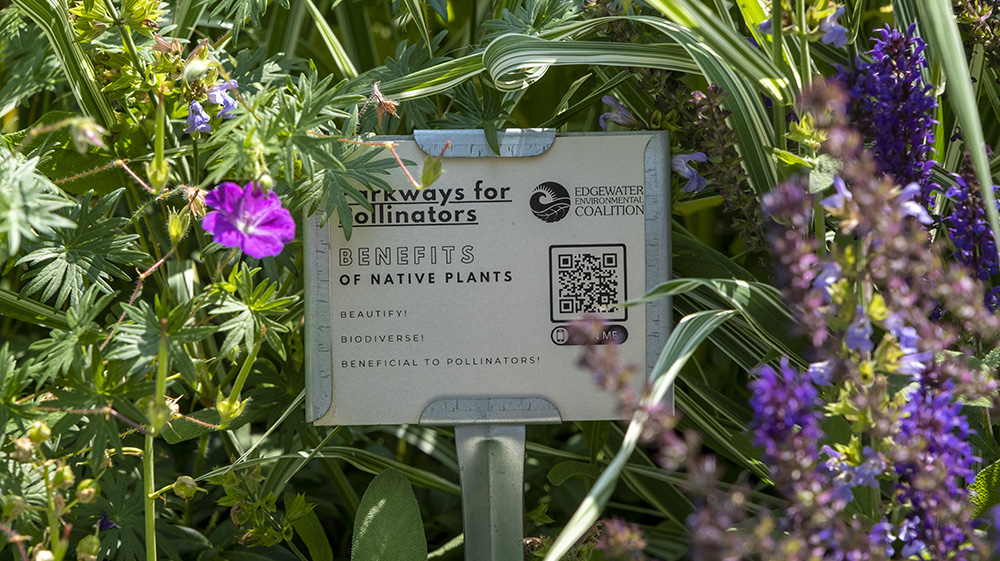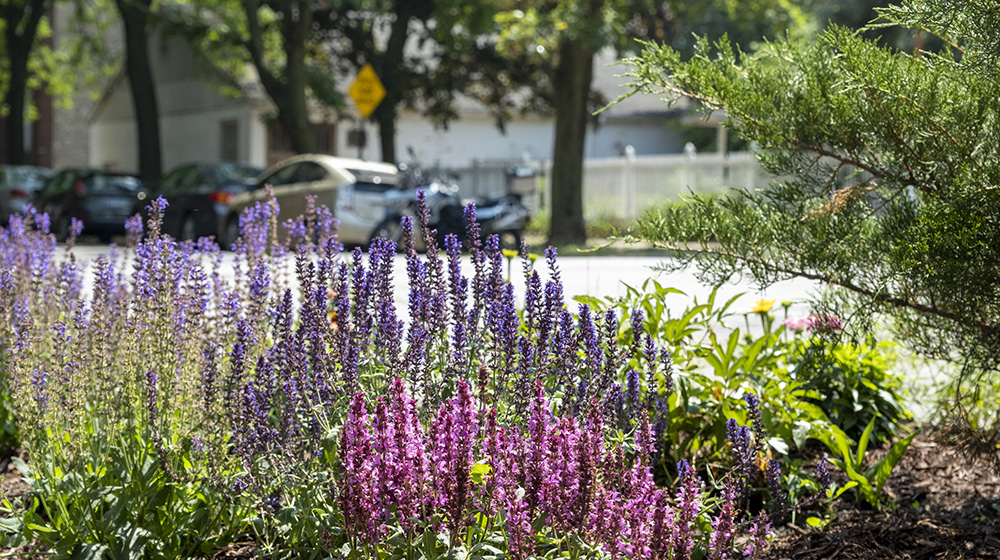Parkways-for-pollinators
Community Partnership Supports Native Plants and Pollinators
Community engagement is a core element of Loyola University Chicago’s Urban Agriculture program. Student participants sell produce at local farmers markets, donate fresh vegetables to neighborhood food pantries, and distribute plants to community groups. The program team also works with the Edgewater Environmental Coalition (EEC) to help disperse native plants throughout the neighborhood.

The SES Urban Agriculture Program collaborates with the Edgewater Environmental Coalition to distribute native plants in the community.
The EEC is a group of community members dedicated to promoting sustainability in Chicago’s Edgewater neighborhood. Around eight years ago, Kevin Erickson, the urban agriculture program manager, connected with EEC through a community member. Initially, the program donated extra plants to EEC after their annual plant sale and collaborated on EEC’s efforts to help Monarch butterfly populations by planting milkweed.
This relationship grew, and the Urban Agriculture team now grows native plants specifically for EEC. Two years ago, the community group launched its Parkways for Pollinators program to distribute native plants for neighbors to plant in public spaces. The project aims to provide habitat and food for pollinators in Chicago.
The team uses seeds collected through EEC’s native seed collection program and the Field Museum. Erickson and his team of students grow and tend to the native plants in Loyola’s greenhouse before delivering seedlings to EEC. This season, the team produced nearly 1,500 plants for Parkways for Pollinators, including wildflower species such as purple coneflower, black-eyed Susan, and goldenrod. Compared to last year, Parkways for Pollinators has doubled in size, from approximately 50 planting sites in 2022 to 100 locations in 2023.
“We would not be able to do all that we are doing with this project without the partnership with Loyola’s Urban Agriculture program, which has been a longtime collaborator with EEC,” said Renee Patten, co-chair at EEC.

Native plants add beauty to the community while providing food and habitat for beneficial insects and birds.
The Parkways for Pollinators program has ecological and educational benefits. On the environmental side, having more native plants throughout Chicago is vital because they provide food and habitat for birds and native insects such as bees and butterflies.
Erickson says the effort helps advance the urban agriculture program’s central goals.
“We aim to use our resources on campus, like the SES greenhouse, to advance local food system development and build strong urban ecological systems. Working with partners like EEC helps us expand our efforts throughout the community,” Erickson said.
As for the educational aspects of the Parkways for Pollinators program, the effort demonstrates how flowers and plants can be ecologically beneficial as well as aesthetically pleasing.
“Many of our plant choices seem innocuous, but choosing nonnative species for aesthetic purposes can be ecologically harmful. Choosing native species, which can still serve an aesthetic purpose, supports pollinators and insect and bird populations,” Erickson explained.
The Urban Agriculture Program has also worked to support pollinators through a project called Milkweed for Monarchs, which an SES student ran from 2015 to 2016. Monarch butterflies, native to North America, are an endangered species, and their population has decreased by over 90 percent since the 1970s. Much of this decline has to do with a lack of habitat. Monarchs lay their eggs only on species of milkweed. The student project provided educational workshops and planted milkweed at Edgewater and Rogers Park schools.
The Urban Agriculture team also has a variety of native plants in Winthrop Garden, where they grow food using sustainable, organic methods. Edible food-producing plants in the garden include blackberry, elderberry, sunchokes, and currants. These crops provide food and habitat for native insects and birds, and they require little care once established.
“We don’t have to water our native plants a lot, and we don’t have to add fertilizer because they’ve evolved to this region’s climate and soil structures. They are also perennial, so we don’t have to replant them every year,” Erickson explained.
The native plants have the added benefit of attracting species that pollinate other food crops in the garden. From parkway plantings to urban vegetable gardens, native plants are vital for healthy ecological systems that support wildlife, create beautiful urban green spaces, and produce food for the community.
Learn more about the opportunities and initiatives in Loyola’s Urban Agriculture Program here.
Story by Alex Quebbeman
Photos by Jorge Haddad
Community Partnership Supports Native Plants and Pollinators
Community engagement is a core element of Loyola University Chicago’s Urban Agriculture program. Student participants sell produce at local farmers markets, donate fresh vegetables to neighborhood food pantries, and distribute plants to community groups. The program team also works with the Edgewater Environmental Coalition (EEC) to help disperse native plants throughout the neighborhood.
The EEC is a group of community members dedicated to promoting sustainability in Chicago’s Edgewater neighborhood. Around eight years ago, Kevin Erickson, the urban agriculture program manager, connected with EEC through a community member. Initially, the program donated extra plants to EEC after their annual plant sale and collaborated on EEC’s efforts to help Monarch butterfly populations by planting milkweed.
This relationship grew, and the Urban Agriculture team now grows native plants specifically for EEC. Two years ago, the community group launched its Parkways for Pollinators program to distribute native plants for neighbors to plant in public spaces. The project aims to provide habitat and food for pollinators in Chicago.
The team uses seeds collected through EEC’s native seed collection program and the Field Museum. Erickson and his team of students grow and tend to the native plants in Loyola’s greenhouse before delivering seedlings to EEC. This season, the team produced nearly 1,500 plants for Parkways for Pollinators, including wildflower species such as purple coneflower, black-eyed Susan, and goldenrod. Compared to last year, Parkways for Pollinators has doubled in size, from approximately 50 planting sites in 2022 to 100 locations in 2023.
“We would not be able to do all that we are doing with this project without the partnership with Loyola’s Urban Agriculture program, which has been a longtime collaborator with EEC,” said Renee Patten, co-chair at EEC.
The Parkways for Pollinators program has ecological and educational benefits. On the environmental side, having more native plants throughout Chicago is vital because they provide food and habitat for birds and native insects such as bees and butterflies.
Erickson says the effort helps advance the urban agriculture program’s central goals.
“We aim to use our resources on campus, like the SES greenhouse, to advance local food system development and build strong urban ecological systems. Working with partners like EEC helps us expand our efforts throughout the community,” Erickson said.
As for the educational aspects of the Parkways for Pollinators program, the effort demonstrates how flowers and plants can be ecologically beneficial as well as aesthetically pleasing.
“Many of our plant choices seem innocuous, but choosing nonnative species for aesthetic purposes can be ecologically harmful. Choosing native species, which can still serve an aesthetic purpose, supports pollinators and insect and bird populations,” Erickson explained.
The Urban Agriculture Program has also worked to support pollinators through a project called Milkweed for Monarchs, which an SES student ran from 2015 to 2016. Monarch butterflies, native to North America, are an endangered species, and their population has decreased by over 90 percent since the 1970s. Much of this decline has to do with a lack of habitat. Monarchs lay their eggs only on species of milkweed. The student project provided educational workshops and planted milkweed at Edgewater and Rogers Park schools.
The Urban Agriculture team also has a variety of native plants in Winthrop Garden, where they grow food using sustainable, organic methods. Edible food-producing plants in the garden include blackberry, elderberry, sunchokes, and currants. These crops provide food and habitat for native insects and birds, and they require little care once established.
“We don’t have to water our native plants a lot, and we don’t have to add fertilizer because they’ve evolved to this region’s climate and soil structures. They are also perennial, so we don’t have to replant them every year,” Erickson explained.
The native plants have the added benefit of attracting species that pollinate other food crops in the garden. From parkway plantings to urban vegetable gardens, native plants are vital for healthy ecological systems that support wildlife, create beautiful urban green spaces, and produce food for the community.
Learn more about the opportunities and initiatives in Loyola’s Urban Agriculture Program here.
Story by Alex Quebbeman
Photos by Jorge Haddad
